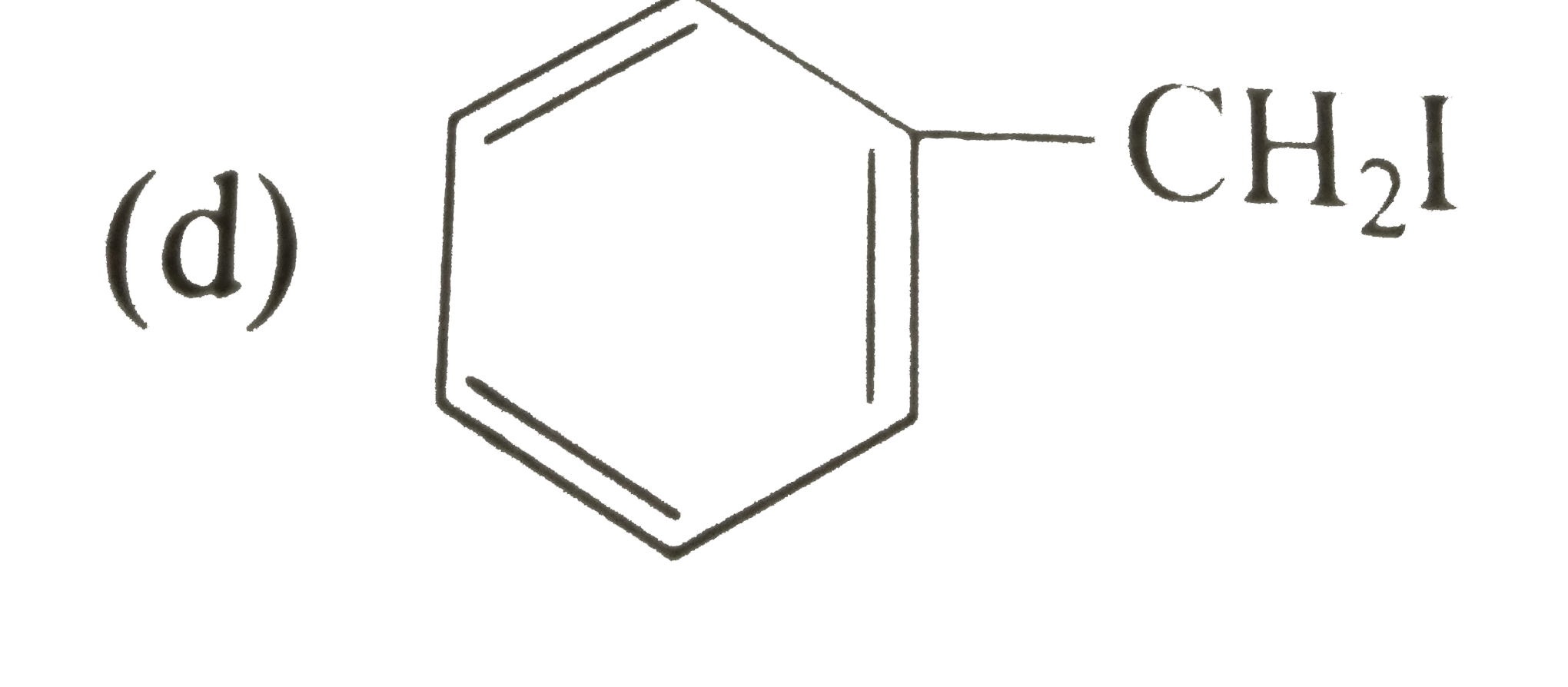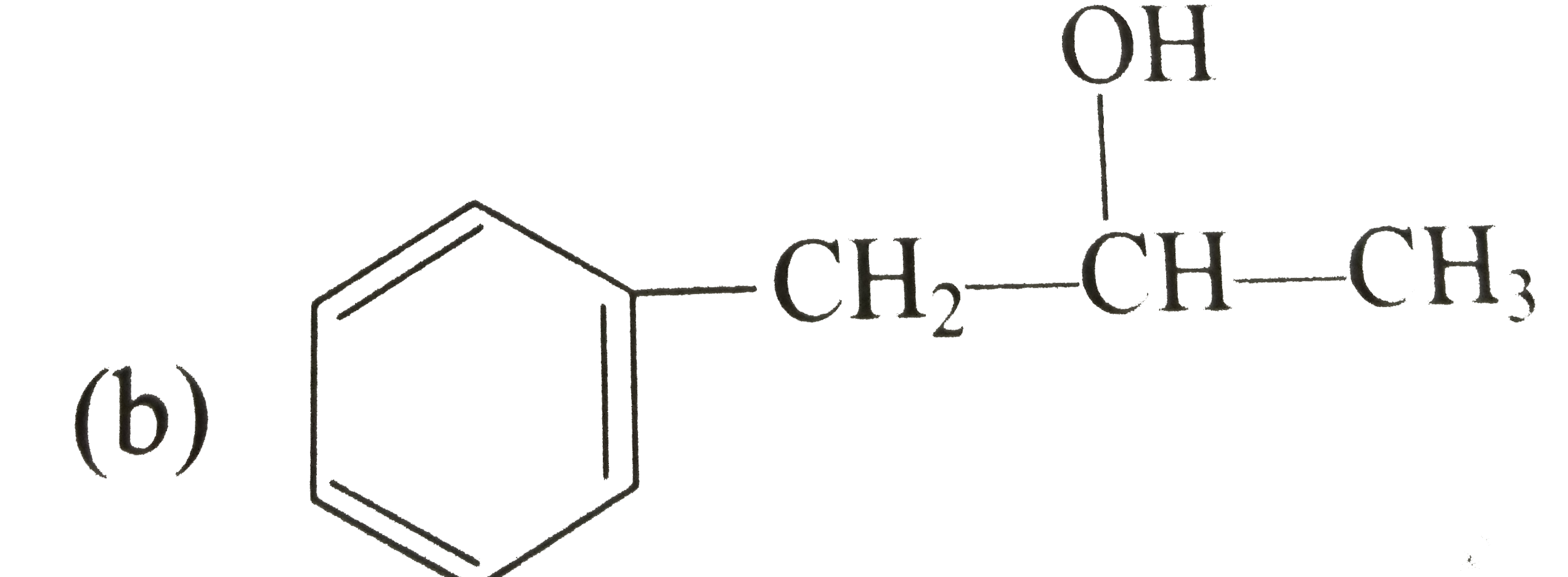An aromatic compound (A), was subjeted to a series of tests in the laboratory. It was found that this compound
(i) does not form silver mirror with Tollens' reagent.
(ii) rotates the plane of polarised light.
(iii) reacts with sodium metal to evolve hydrogen gas. ltbr> (iv) does not decolourise pink colour of bromine water.
(v) reacts with hot to form monocarboxylic acid 'B' which on decarboxylation gives benzene.
(vi) reacts with Lucas reagent in about 5 min.
(vii) reacts with and NaOH to produce yellow coloured precipitation of the compound (C ) .
(viii) loses its optical activity due to formation of compound (D ) on reaction with Red P and HI.
Monocarboxylic acid (B) will be
The correct Answer is:B
Topper's Solved these Questions
- BOOK - OP TANDONCHAPTER - ALCOHOLS, PHENOLS AND ETHERSEXERCISE - ETHERS Passage 65videos
ALCOHOLS, PHENOLS AND ETHERS
- BOOK - OP TANDONCHAPTER - ALCOHOLS, PHENOLS AND ETHERSEXERCISE - Passage 76videos
ALCOHOLS, PHENOLS AND ETHERS
- BOOK - OP TANDONCHAPTER - ALCOHOLS, PHENOLS AND ETHERSEXERCISE - Passage 45videos
ALCOHOLS, PHENOLS AND ETHERS
- BOOK - OP TANDONCHAPTER - ALDEHYDES AND KETONES EXERCISE - SINGLE INTEGER ANSWER TYPE QUESTIONS10videos
ALDEHYDES AND KETONES
Similar Questions

Which among the above compound/s does/do not form Silver mirror when treated with Tollen's reagent?View SolutionAn aromatic compound (A), C9H12O was subjeted to a series of tests in the laboratory. It was found that this compound ,
(i) does not form silver mirror with Tollens' reagent.
(ii) rotates the plane of polarised light.
(iii) reacts with sodium metal to evolve hydrogen gas. ltbr> (iv) does not decolourise pink colour of bromine water.
(v) reacts with hot KMnO4 to form monocarboxylic acid 'B' which on decarboxylation gives benzene.
(vi) reacts with Lucas reagent in about 5 min.
(vii) reacts with I2 and NaOH to produce yellow coloured precipitation of the compound (C ) .
(viii) loses its optical activity due to formation of compound (D ) on reaction with Red P and HI.
The functional groups present in the compound (A) is :View Solution
Knowledge Check
- Question 1 - Select One
An aromatic compound (A), C9H12O was subjeted to a series of tests in the laboratory. It was found that this compound ,
(i) does not form silver mirror with Tollens' reagent.
(ii) rotates the plane of polarised light.
(iii) reacts with sodium metal to evolve hydrogen gas. ltbr> (iv) does not decolourise pink colour of bromine water.
(v) reacts with hot KMnO4 to form monocarboxylic acid 'B' which on decarboxylation gives benzene.
(vi) reacts with Lucas reagent in about 5 min.
(vii) reacts with I2 and NaOH to produce yellow coloured precipitation of the compound (C ) .
(viii) loses its optical activity due to formation of compound (D ) on reaction with Red P and HI.
The compound (D ) will be :AC6H5CH2CH2CH3BC6H5CH2CH2COOHCC6H5CH2CH2CHODC6H5CH2−O∣∣C−CH3 - Question 2 - Select One
An aromatic compound (A), C9H12O was subjeted to a series of tests in the laboratory. It was found that this compound ,
(i) does not form silver mirror with Tollens' reagent.
(ii) rotates the plane of polarised light.
(iii) reacts with sodium metal to evolve hydrogen gas. ltbr> (iv) does not decolourise pink colour of bromine water.
(v) reacts with hot KMnO4 to form monocarboxylic acid 'B' which on decarboxylation gives benzene.
(vi) reacts with Lucas reagent in about 5 min.
(vii) reacts with I2 and NaOH to produce yellow coloured precipitation of the compound (C ) .
(viii) loses its optical activity due to formation of compound (D ) on reaction with Red P and HI.
Molecular formula of the compound (C ) will be :ACH3IB CCHI3D
CCHI3D
- Question 3 - Select One
An aromatic compound (A), C9H12O was subjeted to a series of tests in the laboratory. It was found that this compound ,
(i) does not form silver mirror with Tollens' reagent.
(ii) rotates the plane of polarised light.
(iii) reacts with sodium metal to evolve hydrogen gas. ltbr> (iv) does not decolourise pink colour of bromine water.
(v) reacts with hot KMnO4 to form monocarboxylic acid 'B' which on decarboxylation gives benzene.
(vi) reacts with Lucas reagent in about 5 min.
(vii) reacts with I2 and NaOH to produce yellow coloured precipitation of the compound (C ) .
(viii) loses its optical activity due to formation of compound (D ) on reaction with Red P and HI.
Structure of the compound (A ) will be :A B
B C
C Dnone of the above
Dnone of the above
An organic compound (A)C8H10O was subjected to a series of test in laboratory.
It was found that this compound :
(i) Rotates the plane polarized light.
(ii) Evolves H2 gas with Na.
(iii) Reaches with I2 and NaOH to produce yellow ppt.
(iv) Does not react with Br2/CCl4
(v) Reacts with hot KMnO4 to form (B)C7H6O2, which can also be synthesized by benzene and carbonyl chloride followed by hydrolysis.
(vi) Loses optical acitvity as a result of reduction with Red P+Hi to form C.
(vii) Reacts with Lucas reagent in about 5 minutes.
Find out structure of compound A:View SolutionAn organic compound (A) C8H10O was subjected to a series of test in laboratory. It was found that this compound :
(i) Rotates the plane polarized light
(ii) Evolves H2 gas with Na.
(iii)Reacts with I2 and NaOH to produce yellow ppt.
(iv) Does not react with Br2/CCl4
(v) Reats wtih not KMnO4 to form (B)C7H6O2, which can also be synthesized by benzene and carbonyl chloride followed by hydrolysis.
(vi) Loses optical activity as a result of reduction with Res P+HI to form 'C'
(vii) Reacts with Lucas reagent in about 5 minutes.
Find out structure of compound 'A' :View SolutionAn organic compound (A)C8H10O was subjected to a series of test in laboratory.
It was found that this compound :
(i) Rotates the plane polarized light.
(ii) Evolves H2 gas with Na.
(iii) Reaches with I2 and NaOH to produce yellow ppt.
(iv) Does not react with Br2/CCl4
(v) Reacts with hot KMnO4 to form (B)C7H6O2, which can also be synthesized by benzene and carbonyl chloride followed by hydrolysis.
(vi) Loses optical acitvity as a result of reduction with Red P+Hi to form C.
(vii) Reacts with Lucas reagent in about 5 minutes.
Compounds B and C are respectively:View SolutionThe compound which reacts with hydroxylamine but does not react with Tollen's reagent is
View SolutionAn organic compound (A) C8H10O was subjected to a series of test in laboratory. It was found that this compound :
(i) Rotates the plane polarized light
(ii) Evolves H2 gas with Na.
(iii)Reacts with I2 and NaOH to produce yellow ppt.
(iv) Does not react with Br2/CCl4
(v) Reats wtih not KMnO4 to form (B)C7H6O2, which can also be synthesized by benzene and carbonyl chloride followed by hydrolysis.
(vi) Loses optical activity as a result of reduction with Res P+HI to form 'C'
(vii) Reacts with Lucas reagent in about 5 minutes.
Compounds B and C are respectively :View Solution

